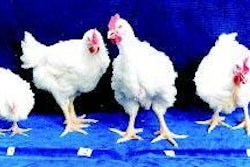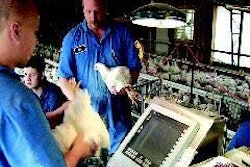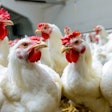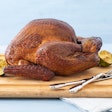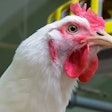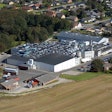Most experts still expect the predicted ‘bird flu’ pandemic in humans to be caused by a strain of the H5N1 subtype, but agree the threat could come any time from another subtype of the influenza A virus. The recent outbreak of H7N2 in North Wales and North West England which started in poultry but quickly spread to people on a speed and scale not seen before gave the world a timely warning of this danger.
Audible sighs of relief greeted confirmation of “low path” H7N2 as cause of an outbreak of bird flu (Influenza A virus) at Corwen in Conwy North Wales (May 24 2007) by Chief Veterinary Officer for Wales Dr Christine Glossop. Though clearly not the ultra deadly “high path” H5N1, which “despatched” 160,000 Bernard Matthews turkeys in February 2007, the outbreak still generated hundreds of news items across the world with headlines like “British bird flu not deadly” and “Benign bird flu strikes UK”. But it was deadly enough for the fifteen 22-week old Rhode Island Red hens purchased by the smallholder two weeks before in a market at Macclesfield in the English County of Cheshire 100 km away.
UK has relatively little experience of bird flu irrespective of subtype and pathogenicity (virulence), but poultry farmers in countries like USA with many outbreaks of H7N2 will confirm there is no such thing as “benign” bird flu. Most influenza A viruses (including H5N1) originating in birds usually occur as “low path” strains. But all have the potential to mutate into “high path” types during course of an outbreak and are viewed as such by poultry industries and governments worldwide. Even nominally “low path” strains of H7N2 may cause “moderate” mortality in poultry as this North Wales experience shows.
In 1994 an H7N2 subtype avian influenza of low pathogenicity was detected in “Live Bird Markets” (LBMs) in North East United States. H7N2 subsequently circulated in the LBM network, despite efforts to eradicate the virus by market closures and extensive cleaning and disinfection, and went on to infect poultry farms up and down the eastern United States.
In 1997/1998 H7N2 appeared in Pennsylvania, causing destruction of 2.5 million birds through a depopulation management strategy before it was brought under control. A H7N2 outbreak in spring and summer 2002 affecting Virginia, West Virginia and North Carolina was originally characterised as “low path”, but before its final containment 20 per cent of the area’s poultry farms were testing positive for H7N2, resulting in destruction of 4.7 million chickens and turkeys with another 56 million birds put at risk.
A 2003 outbreak in Connecticut was potentially devastating too, but on this occasion poultry vaccination was used as an alternative “tool” to protect the state’s huge layer flocks. During 1994-2003 between 30 and 808 isolations of H7N2 were made every year (total 3634) in the United States. The H7N2 subtype is highly transmissible in poultry but transmission to humans is considered rare. This was the most interesting and worrying aspect of the H7N2 UK outbreak, because a relatively large number of people began to show flu like symptoms and conjunctivitis and test positive for H7N2.
There have only been isolated H7N2 human infections in the United States including one in Virginia (2002) and a more serious infection in New York (2003) requiring several weeks of hospital treatment. But this is around big outbreaks in poultry over many years. The UK virus started to spread to people with alarming speed. By 1 June 2007 seventeen (including a schoolchild) were showing symptoms, four of whom tested positive for H7N2. After initially playing down the disease as “low path” and mainly affecting poultry, health authorities were forced to reassess the situation.
Dr Marion Lyons lead consultant in communicable disease control with the National Public Health Service for Wales NPHS) said “Of the people with conjunctivitis or a flu-like illness, some did not have close contact with infected poultry and for this reason person-to-person contact cannot be ruled out”.
NPHS identified 256 people who they said may have had contact with this avian influenza virus. They were 39 household residents, 14 at a school and 203 in the workplace environment. Definitions of cases and contacts used were:
- A Case – any individual with influenza-like illness (fever above 38ºC, aches and pains, cough/head cold, sore throat or conjunctivitis) who has been in contact with affected premises or known infected poultry (handling or within one metre) or close contact with another human case.
- A Contact – defined as an individual who has been in contact with affected premises or with known infected poultry (handling or within one metre) or has had close contact with another person with confirmed or presumptive avian influenza.
Classmates and teachers of the infected schoolchild were offered treatment with the anti-viral drug Tamiflu as a precaution. The authorities continually stressed the mildness of any illness suffered. Chief medical officer for Wales Dr Tony Jewell told the press “I would like to reassure the general public that risk to their health from this outbreak is very low”.
But a couple from North West England who contracted the disease after visiting the same poultry market in Cheshire told the press how they experienced severe illness and quote “thought we were going to die”. One of the rare human cases in the United States involved severe illness and hospitalisation over several weeks.
North American strains of H7N2 are nominally “low path” but US scientists have observed several changes in the amino-acid motif at the cleavage site of the H protein of H7N2, suggesting the virus has been moving towards a highly pathogenic form. Mutations that change a virus from “low path” to “high path” during replication in unnatural hosts (e.g. domesticated birds and humans) are well established for a number of subtypes other than H5N1. The H7N3 outbreak in British Colombia, Canada during 2004 which led to destruction of 19 million birds is a classic example. Poultry industries and governments make little distinction between any H5 and H7 subtype when it comes to import restrictions, as hard pressed British poultry exporters still reeling after the Bernard Matthews H5N1 outbreak quickly found to their cost. The Irish Republic’s Agriculture Minister Mary Coughlan announced an immediate ban on the import of birds from mainland United Kingdom (not Northern Ireland), with the exception of racing pigeons and other captive poultry participating in bird gatherings and shows.
Apart from the rapid transmission from poultry to humans the other strange thing about this outbreak is that no one appears to be questioning or trying to identify source and route of the virus into the market at Macclesfield. The Rhode Island Red hens came from somewhere so there is almost certainly a farm, smallholding or even back yard flock somewhere in the United Kingdom, or perhaps another European Union (EU) country, with birds acting as reservoir of H7N2 with an extraordinary and potentially dangerous human dimension.
Perhaps final words on this strain and outbreak should go to virologists and avian influenza experts in the United States, who have far more experience with H7N2 than scientists elsewhere. WHO bird flu expert Dr Michael Perdue told the International Herald Tribune “There may be a bit of complacency when it comes to recognizing the pandemic potential of H7 viruses. Here we are talking about a small number of birds and yet we still have four (human) cases”, said Perdue. “Unless there’s something unusual about the (human) contact with birds it suggests the virus is finding new ways of getting into humans. If you have an H7 virus causing mild symptoms, that might give the virus the chance to ‘reassort’ into a more dangerous virus before anybody notices”, said Dr Perdue.


